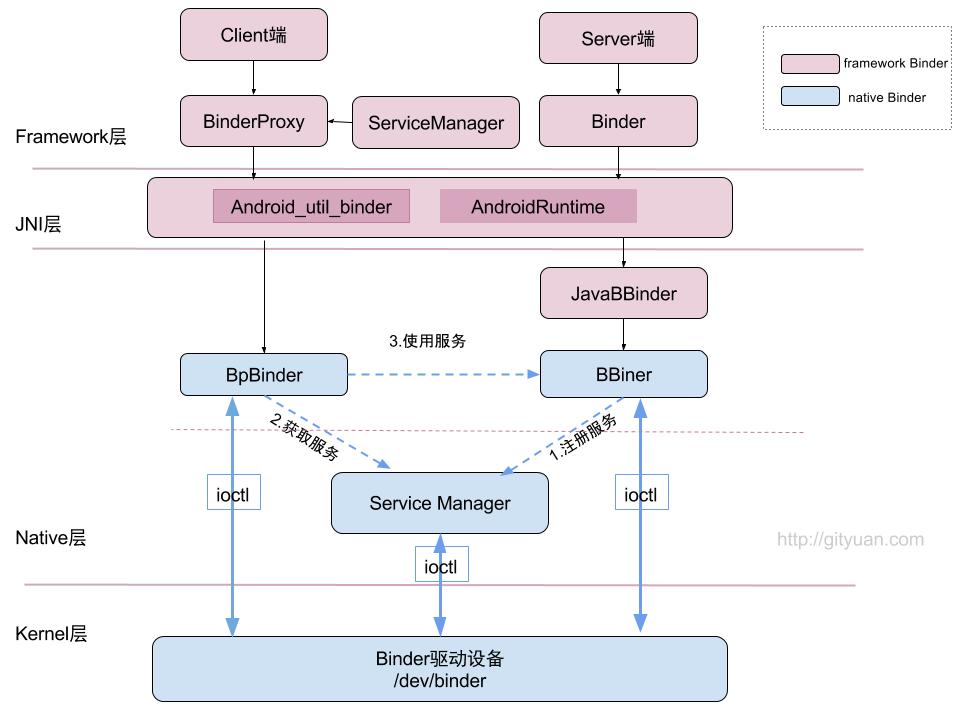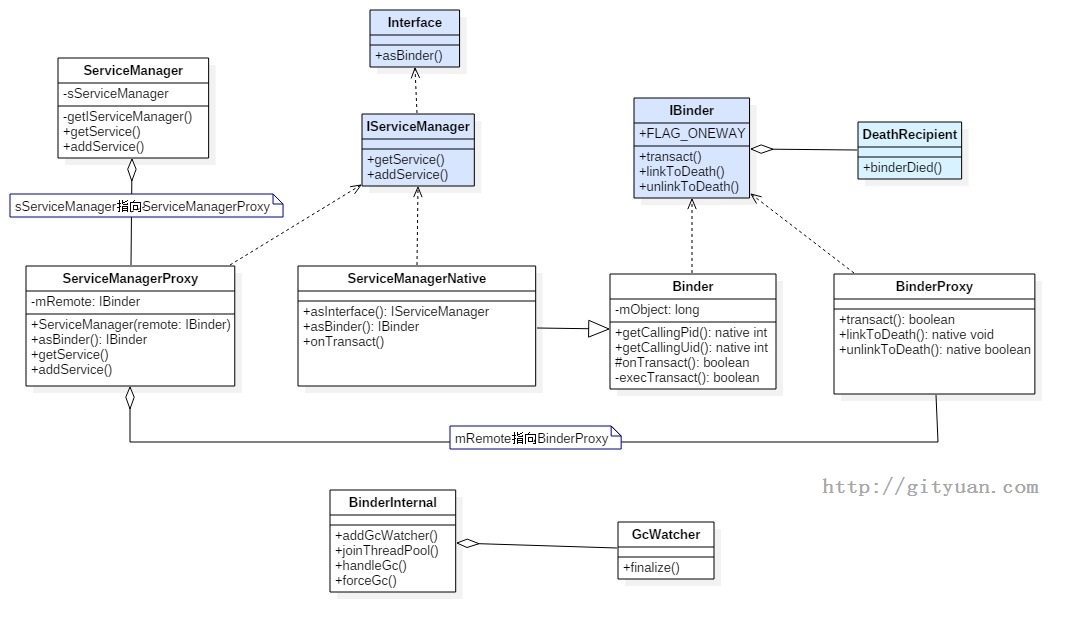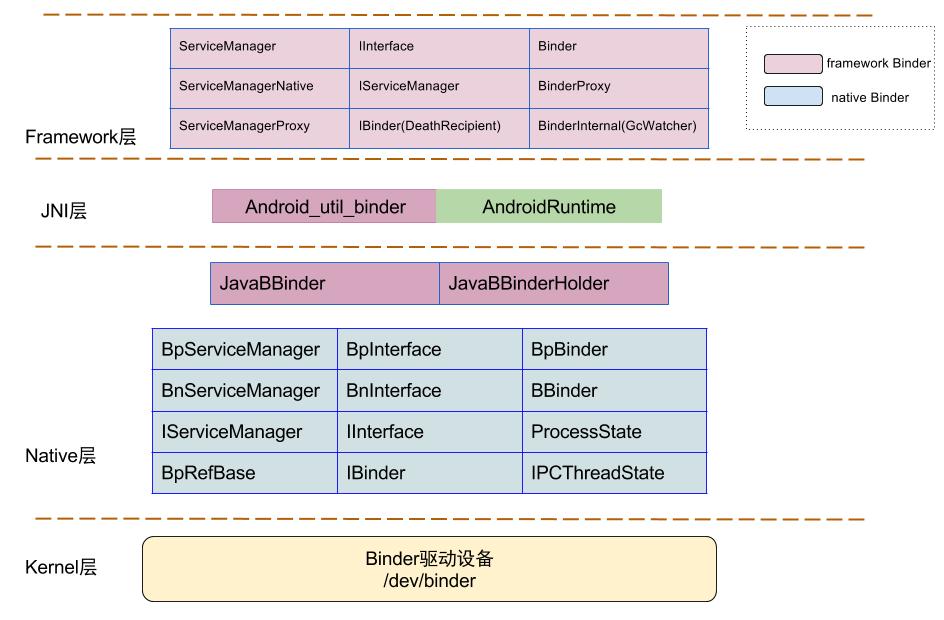copy from :http://gityuan.com/2015/11/21/binder-framework/
主要分析Binder在java framework层的框架,相关源码:
framework/base/core/java/android/os/
- IInterface.java
- IServiceManager.java
- ServiceManager.java
- ServiceManagerNative.java(内含ServiceManagerProxy类)
framework/base/core/java/android/os/
- IBinder.java
- Binder.java(内含BinderProxy类)
- Parcel.java
framework/base/core/java/com/android/internal/os/
- BinderInternal.java
framework/base/core/jni/
- AndroidRuntime.cpp
- android_os_Parcel.cpp
- android_util_Binder.cpp
一、概述
1.1 Binder架构
binder在framework层,采用JNI技术来调用native(C/C++)层的binder架构,从而为上层应用程序提供服务。 看过binder系列之前的文章,我们知道native层中,binder是C/S架构,分为Bn端(Server)和Bp端(Client)。对于java层在命名与架构上非常相近,同样实现了一套IPC通信架构。
framework Binder架构图:查看大图

图解:
- 图中红色代表整个framework层 binder架构相关组件;
- Binder类代表Server端,BinderProxy类代码Client端;
- 图中蓝色代表Native层Binder架构相关组件;
- 上层framework层的Binder逻辑是建立在Native层架构基础之上的,核心逻辑都是交予Native层方法来处理。
- framework层的ServiceManager类与Native层的功能并不完全对应,framework层的ServiceManager类的实现最终是通过BinderProxy传递给Native层来完成的,后面会详细说明。
1.2 Binder类图
下面列举framework的binder类关系图:查看大图

图解:(图中浅蓝色都是Interface,其余都是Class)
- ServiceManager:通过getIServiceManager方法获取的是ServiceManagerProxy对象; ServiceManager的addService, getService实际工作都交由ServiceManagerProxy的相应方法来处理;
- ServiceManagerProxy:其成员变量mRemote指向BinderProxy对象,ServiceManagerProxy的addService, getService方法最终是交由mRemote来完成。
- ServiceManagerNative:其方法asInterface()返回的是ServiceManagerProxy对象,ServiceManager便是借助ServiceManagerNative类来找到ServiceManagerProxy;
- Binder:其成员变量mObject和方法execTransact()用于native方法
- BinderInternal:内部有一个GcWatcher类,用于处理和调试与Binder相关的垃圾回收。
- IBinder:接口中常量FLAG_ONEWAY:客户端利用binder跟服务端通信是阻塞式的,但如果设置了FLAG_ONEWAY,这成为非阻塞的调用方式,客户端能立即返回,服务端采用回调方式来通知客户端完成情况。另外IBinder接口有一个内部接口DeathDecipient(死亡通告)。
1.3 Binder类分层
整个Binder从kernel至,native,JNI,Framework层所涉及的全部类
点击查看大图

二、初始化
在Android系统开机过程中,Zygote启动时会有一个虚拟机注册过程,该过程调用AndroidRuntime::startReg方法来完成jni方法的注册。
2.1 startReg
==> AndroidRuntime.cpp
int AndroidRuntime::startReg(JNIEnv* env)
{
androidSetCreateThreadFunc((android_create_thread_fn) javaCreateThreadEtc);
env->PushLocalFrame(200);
//注册jni方法【见2.2】
if (register_jni_procs(gRegJNI, NELEM(gRegJNI), env) < 0) {
env->PopLocalFrame(NULL);
return -1;
}
env->PopLocalFrame(NULL);
return 0;
}
注册JNI方法,其中gRegJNI是一个数组,记录所有需要注册的jni方法,其中有一项便是REG_JNI(register_android_os_Binder),下面说说register_android_os_Binder过程。
2.2 register_android_os_Binder
==> android_util_Binder.cpp
int register_android_os_Binder(JNIEnv* env) {
// 注册Binder类的jni方法【见2.3】
if (int_register_android_os_Binder(env) < 0)
return -1;
// 注册BinderInternal类的jni方法【见2.4】
if (int_register_android_os_BinderInternal(env) < 0)
return -1;
// 注册BinderProxy类的jni方法【见2.5】
if (int_register_android_os_BinderProxy(env) < 0)
return -1;
...
return 0;
}
2.3 注册Binder
==> android_util_Binder.cpp
static int int_register_android_os_Binder(JNIEnv* env) {
//其中kBinderPathName = "android/os/Binder";查找kBinderPathName路径所属类
jclass clazz = FindClassOrDie(env, kBinderPathName);
//将Java层Binder类保存到mClass变量;
gBinderOffsets.mClass = MakeGlobalRefOrDie(env, clazz);
//将Java层execTransact()方法保存到mExecTransact变量;
gBinderOffsets.mExecTransact = GetMethodIDOrDie(env, clazz, "execTransact", "(IJJI)Z");
//将Java层mObject属性保存到mObject变量
gBinderOffsets.mObject = GetFieldIDOrDie(env, clazz, "mObject", "J");
//注册JNI方法
return RegisterMethodsOrDie(env, kBinderPathName, gBinderMethods,
NELEM(gBinderMethods));
}
注册 Binder类的jni方法,其中:
- FindClassOrDie(env, kBinderPathName) 基本等价于 env->FindClass(kBinderPathName)
- MakeGlobalRefOrDie() 等价于 env->NewGlobalRef()
- GetMethodIDOrDie() 等价于 env->GetMethodID()
- GetFieldIDOrDie() 等价于 env->GeFieldID()
- RegisterMethodsOrDie() 等价于 Android::registerNativeMethods();
(1)gBinderOffsets
gBinderOffsets是全局静态结构体(struct),定义如下:
static struct bindernative_offsets_t
{
jclass mClass; //记录Binder类
jmethodID mExecTransact; //记录execTransact()方法
jfieldID mObject; //记录mObject属性
} gBinderOffsets;
gBinderOffsets保存了Binder.java类本身以及其成员方法execTransact()和成员属性mObject,这为JNI层访问Java层提供通道。另外通过查询获取Java层 binder信息后保存到gBinderOffsets,而不再需要每次查找binder类信息的方式能大幅度提高效率,是由于每次查询需要花费较多的CPU时间,尤其是频繁访问时,但用额外的结构体来保存这些信息,是以空间换时间的方法。
(2)gBinderMethods
static const JNINativeMethod gBinderMethods[] = {
/* 名称, 签名, 函数指针 */
{ "getCallingPid", "()I", (void*)android_os_Binder_getCallingPid },
{ "getCallingUid", "()I", (void*)android_os_Binder_getCallingUid },
{ "clearCallingIdentity", "()J", (void*)android_os_Binder_clearCallingIdentity },
{ "restoreCallingIdentity", "(J)V", (void*)android_os_Binder_restoreCallingIdentity },
{ "setThreadStrictModePolicy", "(I)V", (void*)android_os_Binder_setThreadStrictModePolicy },
{ "getThreadStrictModePolicy", "()I", (void*)android_os_Binder_getThreadStrictModePolicy },
{ "flushPendingCommands", "()V", (void*)android_os_Binder_flushPendingCommands },
{ "init", "()V", (void*)android_os_Binder_init },
{ "destroy", "()V", (void*)android_os_Binder_destroy },
{ "blockUntilThreadAvailable", "()V", (void*)android_os_Binder_blockUntilThreadAvailable }
};
通过RegisterMethodsOrDie(),将为gBinderMethods数组中的方法建立了一一映射关系,从而为Java层访问JNI层提供通道。
总之,int_register_android_os_Binder方法的主要功能:
- 通过gBinderOffsets,保存Java层Binder类的信息,为JNI层访问Java层提供通道;
- 通过RegisterMethodsOrDie,将gBinderMethods数组完成映射关系,从而为Java层访问JNI层提供通道。
也就是说该过程建立了Binder类在Native层与framework层之间的相互调用的桥梁。
2.4 注册BinderInternal
==> android_util_Binder.cpp
static int int_register_android_os_BinderInternal(JNIEnv* env) {
//其中kBinderInternalPathName = "com/android/internal/os/BinderInternal"
jclass clazz = FindClassOrDie(env, kBinderInternalPathName);
gBinderInternalOffsets.mClass = MakeGlobalRefOrDie(env, clazz);
gBinderInternalOffsets.mForceGc = GetStaticMethodIDOrDie(env, clazz, "forceBinderGc", "()V");
return RegisterMethodsOrDie(
env, kBinderInternalPathName,
gBinderInternalMethods, NELEM(gBinderInternalMethods));
}
注册BinderInternal类的jni方法,gBinderInternalOffsets保存了BinderInternal的forceBinderGc()方法。
下面是BinderInternal类的JNI方法注册:
static const JNINativeMethod gBinderInternalMethods[] = {
{ "getContextObject", "()Landroid/os/IBinder;", (void*)android_os_BinderInternal_getContextObject },
{ "joinThreadPool", "()V", (void*)android_os_BinderInternal_joinThreadPool },
{ "disableBackgroundScheduling", "(Z)V", (void*)android_os_BinderInternal_disableBackgroundScheduling },
{ "handleGc", "()V", (void*)android_os_BinderInternal_handleGc }
};
该过程其【2.3】非常类似,也就是说该过程建立了是BinderInternal类在Native层与framework层之间的相互调用的桥梁。
2.5 注册BinderProxy
==> android_util_Binder.cpp
static int int_register_android_os_BinderProxy(JNIEnv* env) {
//gErrorOffsets保存了Error类信息
jclass clazz = FindClassOrDie(env, "java/lang/Error");
gErrorOffsets.mClass = MakeGlobalRefOrDie(env, clazz);
//gBinderProxyOffsets保存了BinderProxy类的信息
//其中kBinderProxyPathName = "android/os/BinderProxy"
clazz = FindClassOrDie(env, kBinderProxyPathName);
gBinderProxyOffsets.mClass = MakeGlobalRefOrDie(env, clazz);
gBinderProxyOffsets.mConstructor = GetMethodIDOrDie(env, clazz, "<init>", "()V");
gBinderProxyOffsets.mSendDeathNotice = GetStaticMethodIDOrDie(env, clazz, "sendDeathNotice", "(Landroid/os/IBinder$DeathRecipient;)V");
gBinderProxyOffsets.mObject = GetFieldIDOrDie(env, clazz, "mObject", "J");
gBinderProxyOffsets.mSelf = GetFieldIDOrDie(env, clazz, "mSelf", "Ljava/lang/ref/WeakReference;");
gBinderProxyOffsets.mOrgue = GetFieldIDOrDie(env, clazz, "mOrgue", "J");
//gClassOffsets保存了Class.getName()方法
clazz = FindClassOrDie(env, "java/lang/Class");
gClassOffsets.mGetName = GetMethodIDOrDie(env, clazz, "getName", "()Ljava/lang/String;");
return RegisterMethodsOrDie(
env, kBinderProxyPathName,
gBinderProxyMethods, NELEM(gBinderProxyMethods));
}
注册BinderProxy类的jni方法,gBinderProxyOffsets保存了BinderProxy的构造方法,sendDeathNotice(), mObject, mSelf, mOrgue信息。
下面BinderProxy类的JNI方法注册:
static const JNINativeMethod gBinderProxyMethods[] = {
/* 名称, 签名, 函数指针 */
{"pingBinder", "()Z", (void*)android_os_BinderProxy_pingBinder},
{"isBinderAlive", "()Z", (void*)android_os_BinderProxy_isBinderAlive},
{"getInterfaceDescriptor", "()Ljava/lang/String;", (void*)android_os_BinderProxy_getInterfaceDescriptor},
{"transactNative", "(ILandroid/os/Parcel;Landroid/os/Parcel;I)Z", (void*)android_os_BinderProxy_transact},
{"linkToDeath", "(Landroid/os/IBinder$DeathRecipient;I)V", (void*)android_os_BinderProxy_linkToDeath},
{"unlinkToDeath", "(Landroid/os/IBinder$DeathRecipient;I)Z", (void*)android_os_BinderProxy_unlinkToDeath},
{"destroy", "()V", (void*)android_os_BinderProxy_destroy},
};
该过程其【2.3】非常类似,也就是说该过程建立了是BinderProxy类在Native层与framework层之间的相互调用的桥梁。
三、注册服务
3.1 SM.addService
[-> ServiceManager.java]
public static void addService(String name, IBinder service, boolean allowIsolated) {
try {
//先获取SMP对象,则执行注册服务操作【见小节3.2/3.4】
getIServiceManager().addService(name, service, allowIsolated);
} catch (RemoteException e) {
Log.e(TAG, "error in addService", e);
}
}
先来看看getIServiceManager()过程,如下:
3.2 getIServiceManager
[-> ServiceManager.java]
private static IServiceManager getIServiceManager() {
if (sServiceManager != null) {
return sServiceManager;
}
//【分别见3.2.1和3.3】
sServiceManager = ServiceManagerNative.asInterface(BinderInternal.getContextObject());
return sServiceManager;
}
采用了单例模式获取ServiceManager getIServiceManager()返回的是ServiceManagerProxy(简称SMP)对象
3.2.1 getContextObject()
[-> android_util_binder.cpp]
static jobject android_os_BinderInternal_getContextObject(JNIEnv* env, jobject clazz)
{
sp<IBinder> b = ProcessState::self()->getContextObject(NULL);
return javaObjectForIBinder(env, b); //【见3.2.2】
}
BinderInternal.java中有一个native方法getContextObject(),JNI调用执行上述方法。
对于ProcessState::self()->getContextObject(),在获取ServiceManager的第3节已详细解决,即ProcessState::self()->getContextObject()等价于 new BpBinder(0);
3.2.2 javaObjectForIBinder
[-> android_util_binder.cpp]
jobject javaObjectForIBinder(JNIEnv* env, const sp<IBinder>& val) {
if (val == NULL) return NULL;
if (val->checkSubclass(&gBinderOffsets)) { //返回false
jobject object = static_cast<JavaBBinder*>(val.get())->object();
return object;
}
AutoMutex _l(mProxyLock);
jobject object = (jobject)val->findObject(&gBinderProxyOffsets);
if (object != NULL) { //第一次object为null
jobject res = jniGetReferent(env, object);
if (res != NULL) {
return res;
}
android_atomic_dec(&gNumProxyRefs);
val->detachObject(&gBinderProxyOffsets);
env->DeleteGlobalRef(object);
}
//创建BinderProxy对象
object = env->NewObject(gBinderProxyOffsets.mClass, gBinderProxyOffsets.mConstructor);
if (object != NULL) {
//BinderProxy.mObject成员变量记录BpBinder对象
env->SetLongField(object, gBinderProxyOffsets.mObject, (jlong)val.get());
val->incStrong((void*)javaObjectForIBinder);
jobject refObject = env->NewGlobalRef(
env->GetObjectField(object, gBinderProxyOffsets.mSelf));
//将BinderProxy对象信息附加到BpBinder的成员变量mObjects中
val->attachObject(&gBinderProxyOffsets, refObject,
jnienv_to_javavm(env), proxy_cleanup);
sp<DeathRecipientList> drl = new DeathRecipientList;
drl->incStrong((void*)javaObjectForIBinder);
//BinderProxy.mOrgue成员变量记录死亡通知对象
env->SetLongField(object, gBinderProxyOffsets.mOrgue, reinterpret_cast<jlong>(drl.get()));
android_atomic_inc(&gNumProxyRefs);
incRefsCreated(env);
}
return object;
}
根据BpBinder(C++)生成BinderProxy(Java)对象. 主要工作是创建BinderProxy对象,并把BpBinder对象地址保存到BinderProxy.mObject成员变量. 到此,可知ServiceManagerNative.asInterface(BinderInternal.getContextObject()) 等价于
ServiceManagerNative.asInterface(new BinderProxy())
3.3 SMN.asInterface
[-> ServiceManagerNative.java]
static public IServiceManager asInterface(IBinder obj)
{
if (obj == null) { //obj为BpBinder
return null;
}
//由于obj为BpBinder,该方法默认返回null
IServiceManager in = (IServiceManager)obj.queryLocalInterface(descriptor);
if (in != null) {
return in;
}
return new ServiceManagerProxy(obj); //【见小节3.3.1】
}
由此,可知ServiceManagerNative.asInterface(new BinderProxy()) 等价于new ServiceManagerProxy(new BinderProxy()). 为了方便,ServiceManagerProxy简称为SMP。
3.3.1 ServiceManagerProxy初始化
[-> ServiceManagerNative.java ::ServiceManagerProxy]
class ServiceManagerProxy implements IServiceManager {
public ServiceManagerProxy(IBinder remote) {
mRemote = remote;
}
}
mRemote为BinderProxy对象,该BinderProxy对象对应于BpBinder(0),其作为binder代理端,指向native层大管家service Manager。
ServiceManager.getIServiceManager最终等价于new ServiceManagerProxy(new BinderProxy()),意味着【3.1】中的getIServiceManager().addService(),等价于SMP.addService().
framework层的ServiceManager的调用实际的工作确实交给SMP的成员变量BinderProxy;而BinderProxy通过jni方式,最终会调用BpBinder对象;可见上层binder架构的核心功能依赖native架构的服务来完成的。
3.4 SMP.addService
[-> ServiceManagerNative.java ::ServiceManagerProxy]
public void addService(String name, IBinder service, boolean allowIsolated) throws RemoteException {
Parcel data = Parcel.obtain();
Parcel reply = Parcel.obtain();
data.writeInterfaceToken(IServiceManager.descriptor);
data.writeString(name);
//【见小节3.5】
data.writeStrongBinder(service);
data.writeInt(allowIsolated ? 1 : 0);
//mRemote为BinderProxy【见小节3.7】
mRemote.transact(ADD_SERVICE_TRANSACTION, data, reply, 0);
reply.recycle();
data.recycle();
}
3.5 writeStrongBinder(Java)
[-> Parcel.java]
public writeStrongBinder(IBinder val){
//此处为Native调用【见3.5.1】
nativewriteStrongBinder(mNativePtr, val);
}
3.5.1 android_os_Parcel_writeStrongBinder
[-> android_os_Parcel.cpp]
static void android_os_Parcel_writeStrongBinder(JNIEnv* env, jclass clazz, jlong nativePtr, jobject object) {
//将java层Parcel转换为native层Parcel
Parcel* parcel = reinterpret_cast<Parcel*>(nativePtr);
if (parcel != NULL) {
//【见3.5.2】
const status_t err = parcel->writeStrongBinder(ibinderForJavaObject(env, object));
if (err != NO_ERROR) {
signalExceptionForError(env, clazz, err);
}
}
}
3.5.2 ibinderForJavaObject
[-> android_util_Binder.cpp]
sp<IBinder> ibinderForJavaObject(JNIEnv* env, jobject obj)
{
if (obj == NULL) return NULL;
//Java层的Binder对象
if (env->IsInstanceOf(obj, gBinderOffsets.mClass)) {
JavaBBinderHolder* jbh = (JavaBBinderHolder*)
env->GetLongField(obj, gBinderOffsets.mObject);
return jbh != NULL ? jbh->get(env, obj) : NULL; //【见3.5.3】
}
//Java层的BinderProxy对象
if (env->IsInstanceOf(obj, gBinderProxyOffsets.mClass)) {
return (IBinder*)env->GetLongField(obj, gBinderProxyOffsets.mObject);
}
return NULL;
}
根据Binde(Java)生成JavaBBinderHolder(C++)对象. 主要工作是创建JavaBBinderHolder对象,并把JavaBBinderHolder对象地址保存到Binder.mObject成员变量.
3.5.3 JavaBBinderHolder.get()
[-> android_util_Binder.cpp]
sp<JavaBBinder> get(JNIEnv* env, jobject obj)
{
AutoMutex _l(mLock);
sp<JavaBBinder> b = mBinder.promote();
if (b == NULL) {
//首次进来,创建JavaBBinder对象【见3.5.4】
b = new JavaBBinder(env, obj);
mBinder = b;
}
return b;
}
JavaBBinderHolder有一个成员变量mBinder,保存当前创建的JavaBBinder对象,这是一个wp类型的,可能会被垃圾回收器给回收,所以每次使用前,都需要先判断是否存在。
3.5.4 JavaBBinder初始化
==> [-> android_util_Binder.cpp]
JavaBBinder(JNIEnv* env, jobject object)
: mVM(jnienv_to_javavm(env)), mObject(env->NewGlobalRef(object))
{
android_atomic_inc(&gNumLocalRefs);
incRefsCreated(env);
}
创建JavaBBinder,该对象继承于BBinder对象。
data.writeStrongBinder(service)最终等价于parcel->writeStrongBinder(new JavaBBinder(env, obj));
3.6 writeStrongBinder(C++)
[-> parcel.cpp]
status_t Parcel::writeStrongBinder(const sp<IBinder>& val)
{
return flatten_binder(ProcessState::self(), val, this);
}
3.6.1 flatten_binder
[-> parcel.cpp]
status_t flatten_binder(const sp<ProcessState>& /*proc*/,
const sp<IBinder>& binder, Parcel* out)
{
flat_binder_object obj;
obj.flags = 0x7f | FLAT_BINDER_FLAG_ACCEPTS_FDS;
if (binder != NULL) {
IBinder *local = binder->localBinder();
if (!local) {
BpBinder *proxy = binder->remoteBinder();
const int32_t handle = proxy ? proxy->handle() : 0;
obj.type = BINDER_TYPE_HANDLE; //远程Binder
obj.binder = 0;
obj.handle = handle;
obj.cookie = 0;
} else {
obj.type = BINDER_TYPE_BINDER; //本地Binder,进入该分支
obj.binder = reinterpret_cast<uintptr_t>(local->getWeakRefs());
obj.cookie = reinterpret_cast<uintptr_t>(local);
}
} else {
obj.type = BINDER_TYPE_BINDER; //本地Binder
obj.binder = 0;
obj.cookie = 0;
}
//【见小节3.6.2】
return finish_flatten_binder(binder, obj, out);
}
将Binder对象扁平化,转换成flat_binder_object对象。
- 对于Binder实体,则cookie记录Binder实体的指针;
- 对于Binder代理,则用handle记录Binder代理的句柄;
关于localBinder,代码见Binder.cpp。
BBinder* BBinder::localBinder()
{
return this;
}
BBinder* IBinder::localBinder()
{
return NULL;
}
3.6.2 finish_flatten_binder
inline static status_t finish_flatten_binder(
const sp<IBinder>& , const flat_binder_object& flat, Parcel* out)
{
return out->writeObject(flat, false);
}
再回到小节3.4的addService过程,则接下来进入transact。
3.7 BinderProxy.transact
[-> Binder.java ::BinderProxy]
public boolean transact(int code, Parcel data, Parcel reply, int flags) throws RemoteException {
//用于检测Parcel大小是否大于800k
Binder.checkParcel(this, code, data, "Unreasonably large binder buffer");
return transactNative(code, data, reply, flags); //【见3.8】
}
回到ServiceManagerProxy.addService,其成员变量mRemote是BinderProxy。transactNative经过jni调用,进入下面的方法
3.8 android_os_BinderProxy_transact
[-> android_util_Binder.cpp]
static jboolean android_os_BinderProxy_transact(JNIEnv* env, jobject obj,
jint code, jobject dataObj, jobject replyObj, jint flags)
{
...
//java Parcel转为native Parcel
Parcel* data = parcelForJavaObject(env, dataObj);
Parcel* reply = parcelForJavaObject(env, replyObj);
...
//gBinderProxyOffsets.mObject中保存的是new BpBinder(0)对象
IBinder* target = (IBinder*)
env->GetLongField(obj, gBinderProxyOffsets.mObject);
...
//此处便是BpBinder::transact(), 经过native层,进入Binder驱动程序
status_t err = target->transact(code, *data, reply, flags);
...
return JNI_FALSE;
}
Java层的BinderProxy.transact()最终交由Native层的BpBinder::transact()完成。Native Binder的注册服务(addService)中有详细说明BpBinder执行过程。另外,该方法可抛出RemoteException。
3.9 小结
addService的核心过程:
public void addService(String name, IBinder service, boolean allowIsolated) throws RemoteException {
...
Parcel data = Parcel.obtain(); //此处还需要将java层的Parcel转为Native层的Parcel
data->writeStrongBinder(new JavaBBinder(env, obj));
BpBinder::transact(ADD_SERVICE_TRANSACTION, *data, reply, 0); //与Binder驱动交互
...
}
注册服务过程就是通过BpBinder来发送ADD_SERVICE_TRANSACTION命令,与实现与binder驱动进行数据交互。
四、获取服务
4.1 SM.getService
[-> ServiceManager.java]
public static IBinder getService(String name) {
try {
IBinder service = sCache.get(name); //先从缓存中查看
if (service != null) {
return service;
} else {
return getIServiceManager().getService(name); 【见4.2】
}
} catch (RemoteException e) {
Log.e(TAG, "error in getService", e);
}
return null;
}
关于getIServiceManager(),在前面小节3.2已经讲述了,等价于new ServiceManagerProxy(new BinderProxy())。 其中sCache = new HashMap<String, IBinder>()以hashmap格式缓存已组成的名称。请求获取服务过程中,先从缓存中查询是否存在,如果缓存中不存在的话,再通过binder交互来查询相应的服务。
4.2 SMP.getService
[-> ServiceManagerNative.java ::ServiceManagerProxy]
class ServiceManagerProxy implements IServiceManager {
public IBinder getService(String name) throws RemoteException {
Parcel data = Parcel.obtain();
Parcel reply = Parcel.obtain();
data.writeInterfaceToken(IServiceManager.descriptor);
data.writeString(name);
//mRemote为BinderProxy 【见4.3】
mRemote.transact(GET_SERVICE_TRANSACTION, data, reply, 0);
//从reply里面解析出获取的IBinder对象【见4.8】
IBinder binder = reply.readStrongBinder();
reply.recycle();
data.recycle();
return binder;
}
}
4.3 BinderProxy.transact
[-> Binder.java]
final class BinderProxy implements IBinder {
public boolean transact(int code, Parcel data, Parcel reply, int flags) throws RemoteException {
Binder.checkParcel(this, code, data, "Unreasonably large binder buffer");
return transactNative(code, data, reply, flags);
}
}
4.4 android_os_BinderProxy_transact
[-> android_util_Binder.cpp]
static jboolean android_os_BinderProxy_transact(JNIEnv* env, jobject obj,
jint code, jobject dataObj, jobject replyObj, jint flags)
{
...
//java Parcel转为native Parcel
Parcel* data = parcelForJavaObject(env, dataObj);
Parcel* reply = parcelForJavaObject(env, replyObj);
...
//gBinderProxyOffsets.mObject中保存的是new BpBinder(0)对象
IBinder* target = (IBinder*)
env->GetLongField(obj, gBinderProxyOffsets.mObject);
...
//此处便是BpBinder::transact(), 经过native层[见小节4.5]
status_t err = target->transact(code, *data, reply, flags);
...
return JNI_FALSE;
}
4.5 BpBinder.transact
[-> BpBinder.cpp]
status_t BpBinder::transact(
uint32_t code, const Parcel& data, Parcel* reply, uint32_t flags)
{
if (mAlive) {
// [见小节4.6]
status_t status = IPCThreadState::self()->transact(
mHandle, code, data, reply, flags);
if (status == DEAD_OBJECT) mAlive = 0;
return status;
}
return DEAD_OBJECT;
}
4.6 IPC.transact
[-> IPCThreadState.cpp]
status_t IPCThreadState::transact(int32_t handle,
uint32_t code, const Parcel& data,
Parcel* reply, uint32_t flags)
{
status_t err = data.errorCheck(); //数据错误检查
flags |= TF_ACCEPT_FDS;
....
if (err == NO_ERROR) {
// 传输数据
err = writeTransactionData(BC_TRANSACTION, flags, handle, code, data, NULL);
}
...
// 默认情况下,都是采用非oneway的方式, 也就是需要等待服务端的返回结果
if ((flags & TF_ONE_WAY) == 0) {
if (reply) {
//等待回应事件
err = waitForResponse(reply);
}else {
Parcel fakeReply;
err = waitForResponse(&fakeReply);
}
} else {
err = waitForResponse(NULL, NULL);
}
return err;
}
4.7 IPC.waitForResponse
status_t IPCThreadState::waitForResponse(Parcel *reply, status_t *acquireResult)
{
int32_t cmd;
int32_t err;
while (1) {
if ((err=talkWithDriver()) < NO_ERROR) break;
...
cmd = mIn.readInt32();
switch (cmd) {
case BR_REPLY:
{
binder_transaction_data tr;
err = mIn.read(&tr, sizeof(tr));
if (reply) {
if ((tr.flags & TF_STATUS_CODE) == 0) {
//当reply对象回收时,则会调用freeBuffer来回收内存
reply->ipcSetDataReference(
reinterpret_cast<const uint8_t*>(tr.data.ptr.buffer),
tr.data_size,
reinterpret_cast<const binder_size_t*>(tr.data.ptr.offsets),
tr.offsets_size/sizeof(binder_size_t),
freeBuffer, this);
} else {
...
}
}
}
case :...
}
}
...
return err;
}
那么这个reply是哪来的呢,在文章Binder系列3—启动ServiceManager
4.7.1 binder_send_reply
[-> servicemanager/binder.c]
void binder_send_reply(struct binder_state *bs, struct binder_io *reply, binder_uintptr_t buffer_to_free, int status) {
struct {
uint32_t cmd_free;
binder_uintptr_t buffer;
uint32_t cmd_reply;
struct binder_transaction_data txn;
} __attribute__((packed)) data;
data.cmd_free = BC_FREE_BUFFER; //free buffer命令
data.buffer = buffer_to_free;
data.cmd_reply = BC_REPLY; // reply命令
data.txn.target.ptr = 0;
data.txn.cookie = 0;
data.txn.code = 0;
if (status) {
...
} else {=
data.txn.flags = 0;
data.txn.data_size = reply->data - reply->data0;
data.txn.offsets_size = ((char*) reply->offs) - ((char*) reply->offs0);
data.txn.data.ptr.buffer = (uintptr_t)reply->data0;
data.txn.data.ptr.offsets = (uintptr_t)reply->offs0;
}
//向Binder驱动通信
binder_write(bs, &data, sizeof(data));
}
binder_write将BC_FREE_BUFFER和BC_REPLY命令协议发送给驱动,进入驱动。binder_ioctl -> binder_ioctl_write_read -> binder_thread_write,由于是BC_REPLY命令协议,则进入binder_transaction, 该方法会向请求服务的线程Todo队列插入事务。
接下来,请求服务的进程在执行talkWithDriver的过程执行到binder_thread_read(),处理Todo队列的事务。
4.8 readStrongBinder
[-> Parcel.java]
readStrongBinder的过程基本是writeStrongBinder逆过程。
static jobject android_os_Parcel_readStrongBinder(JNIEnv* env, jclass clazz, jlong nativePtr) {
Parcel* parcel = reinterpret_cast<Parcel*>(nativePtr);
if (parcel != NULL) {
//【见小节4.8.1】
return javaObjectForIBinder(env, parcel->readStrongBinder());
}
return NULL;
}
javaObjectForIBinder 将native层BpBinder对象转换为Java层BinderProxy对象。
4.8.1 readStrongBinder(C++)
[-> Parcel.cpp]
sp<IBinder> Parcel::readStrongBinder() const
{
sp<IBinder> val;
//【见小节4.8.2】
unflatten_binder(ProcessState::self(), *this, &val);
return val;
}
4.8.2 unflatten_binder
[-> Parcel.cpp]
status_t unflatten_binder(const sp<ProcessState>& proc,
const Parcel& in, sp<IBinder>* out)
{
const flat_binder_object* flat = in.readObject(false);
if (flat) {
switch (flat->type) {
case BINDER_TYPE_BINDER:
*out = reinterpret_cast<IBinder*>(flat->cookie);
return finish_unflatten_binder(NULL, *flat, in);
case BINDER_TYPE_HANDLE:
//进入该分支【见4.8.3】
*out = proc->getStrongProxyForHandle(flat->handle);
//创建BpBinder对象
return finish_unflatten_binder(
static_cast<BpBinder*>(out->get()), *flat, in);
}
}
return BAD_TYPE;
}
4.8.3 getStrongProxyForHandle
[-> ProcessState.cpp]
sp<IBinder> ProcessState::getStrongProxyForHandle(int32_t handle)
{
sp<IBinder> result;
AutoMutex _l(mLock);
//查找handle对应的资源项
handle_entry* e = lookupHandleLocked(handle);
if (e != NULL) {
IBinder* b = e->binder;
if (b == NULL || !e->refs->attemptIncWeak(this)) {
...
//当handle值所对应的IBinder不存在或弱引用无效时,则创建BpBinder对象
b = new BpBinder(handle);
e->binder = b;
if (b) e->refs = b->getWeakRefs();
result = b;
} else {
result.force_set(b);
e->refs->decWeak(this);
}
}
return result;
}
经过该方法,最终创建了指向Binder服务端的BpBinder代理对象。回到[小节4.8] 经过javaObjectForIBinder将native层BpBinder对象转换为Java层BinderProxy对象。 也就是说通过getService()最终获取了指向目标Binder服务端的代理对象BinderProxy。
4.9 小结
getService的核心过程:
public static IBinder getService(String name) {
...
Parcel reply = Parcel.obtain(); //此处还需要将java层的Parcel转为Native层的Parcel
BpBinder::transact(GET_SERVICE_TRANSACTION, *data, reply, 0); //与Binder驱动交互
IBinder binder = javaObjectForIBinder(env, new BpBinder(handle));
...
}
javaObjectForIBinder作用是创建BinderProxy对象,并将BpBinder对象的地址保存到BinderProxy对象的mObjects中。 获取服务过程就是通过BpBinder来发送GET_SERVICE_TRANSACTION命令,与实现与binder驱动进行数据交互。
五. 实例
以IWindowManager为例
public interface IWindowManager extends android.os.IInterface {
public static abstract class Stub extends android.os.Binder implements android.view.IWindowManager {
private static final java.lang.String DESCRIPTOR = "android.view.IWindowManager";
public Stub() {
this.attachInterface(this, DESCRIPTOR);
}
public static android.view.IWindowManager asInterface(android.os.IBinder obj) {
if ((obj == null)) {
return null;
}
android.os.IInterface iin = obj.queryLocalInterface(DESCRIPTOR);
if (((iin != null) && (iin instanceof android.view.IWindowManager))) {
return ((android.view.IWindowManager) iin);
}
return new android.view.IWindowManager.Stub.Proxy(obj);
}
public android.os.IBinder asBinder() {
return this;
}
private static class Proxy implements android.view.IWindowManager {
private android.os.IBinder mRemote;
Proxy(android.os.IBinder remote) {
mRemote = remote;
}
public android.os.IBinder asBinder() {
return mRemote;
}
}
...
}
}
5.1 Binder
[-> Binder.java]
public class Binder implements IBinder {
public void attachInterface(IInterface owner, String descriptor) {
mOwner = owner;
mDescriptor = descriptor;
}
public IInterface queryLocalInterface(String descriptor) {
if (mDescriptor.equals(descriptor)) {
return mOwner;
}
return null;
}
}
5.2 BinderProxy
final class BinderProxy implements IBinder {
public IInterface queryLocalInterface(String descriptor) {
return null;
}
}